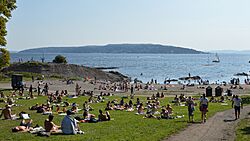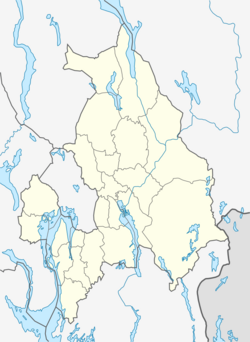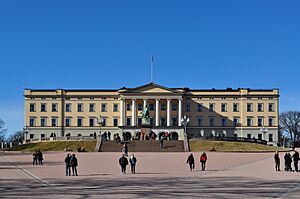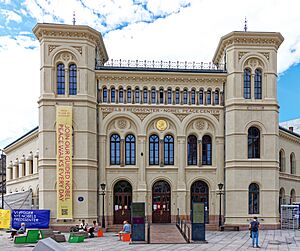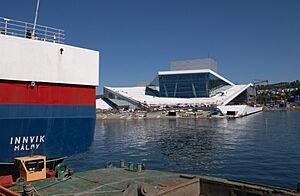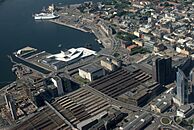Oslo facts for kids
Quick facts for kids
Oslo
|
|||
|---|---|---|---|
|
Capital city, municipality and county
|
|||
| Oslo kommune (Norwegian) Osloven tjïelte (Southern Sami) |
|||
|
Bjørvika
Frogner plass
Victoria Terrasse
Akershus Fortress
Munch Museum
Grünerløkka
Karl Johans gate
Møllergata 19, Youngstorget
Huk at Bygdøy in Oslo
|
|||
|
|||
| Motto(s):
Unanimiter et constanter (Latin)
"United and constant" |
|||
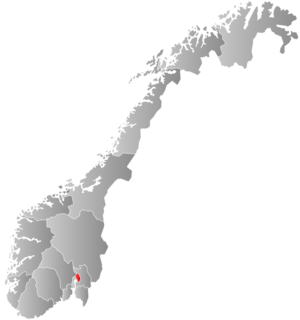
Oslo highlighted in red in Norway
|
|||

Oslo highlighted in red within Akershus County
|
|||
| Country | Norway | ||
| District | Østlandet | ||
| County | Oslo | ||
| Established | 1048 | ||
| Area | |||
| • Capital city, municipality and county | 480 km2 (190 sq mi) | ||
| • Land | 454.20 km2 (175.37 sq mi) | ||
| • Water | 26.64 km2 (10.29 sq mi) | ||
| • Rural | 310 km2 (120 sq mi) | ||
| Highest elevation
(Kjerkeberget)
|
631 m (2,070 ft) | ||
| Lowest elevation | 1 m (3 ft) | ||
| Population
(31 December 2022)
|
|||
| • Capital city, municipality and county | 709,037 |
||
| • Urban | 1,064,235 | ||
| • Metro | 1,588,457 | ||
| GDP | |||
| • Capital city, municipality and county | €70.970 billion (2021) | ||
| • Metro | €132.716 billion (2021) | ||
| Time zone | UTC+01:00 (Central European Time) | ||
| • Summer (DST) | UTC+02:00 (Central European Summer Time) | ||
| Postal code |
0001 – 1299
|
||
| ISO 3166 code | NO-03 | ||
| HDI (2021) | 0.980 very high · 1st |
||
Oslo is the capital and largest city of Norway. It is both a county and a municipality. In 2022, about 709,000 people lived in Oslo. The larger urban area had over 1 million people.
Oslo was founded around 1040, at the end of the Viking Age. It became a trading place in 1048 by Harald Hardrada. Around 1300, it became Norway's capital. After a big fire in 1624, the city was rebuilt and renamed Christiania after King Christian IV. In 1925, its original name, Oslo, was brought back. In 1948, Oslo merged with the larger area of Aker, making the city much bigger.
Today, Oslo is Norway's main center for business and government. It is also important for trade, banking, and shipping in Europe. Many large shipping companies are based here. Oslo is known as a "global city" and has been ranked high for its quality of life. It is also one of the most expensive cities in the world.
Contents
- Discovering Oslo's Location and Layout
- Understanding Oslo's Name and Symbols
- A Journey Through Oslo's Past
- Oslo's Green Spaces and Fun Areas
- Oslo's Modern Look and Buildings
- Oslo's Economy and Business
- Oslo's Commitment to a Green Future
- Learning in Oslo: Education Hub
- Exploring Oslo's Vibrant Culture
- Getting Around Oslo: Transport
- Oslo's Diverse Population
- Famous People from Oslo
- Oslo's Global Connections
- See also
Discovering Oslo's Location and Layout
Oslo is located at the very end of the Oslofjord, a long inlet of the sea. Green hills and mountains surround the city in most other directions. There are 40 islands within the city limits. The largest island is Malmøya. Oslo also has 343 lakes, with Maridalsvannet being the biggest. This lake provides drinking water for much of the city.
Oslo has two smaller rivers: Akerselva and Alna. The waterfalls on Akerselva once powered some of Norway's first modern factories. The highest point in Oslo is Kirkeberget, which is 629 meters high. Even though Oslo has a smaller population than many other European capitals, it covers a very large area. Two-thirds of this area are protected forests, hills, and lakes. This makes Oslo a very green city with many open spaces.
Oslo's Climate and Weather
Oslo has a climate with warm summers and fairly cold winters. It gets a good amount of rain throughout the year. Winter and spring are usually the driest seasons. Summer and autumn are the wettest. Because Oslo is so far north, the amount of daylight changes a lot. In midsummer, it stays light for over 18 hours. In midwinter, it's only light for about 6 hours.
The warmest month ever recorded was July 1901. The hottest temperature ever was 35°C (95°F) in July 1901. The coldest temperature ever recorded was -29.6°C (-21.3°F) in January 1841.
Understanding Oslo's Name and Symbols
After the big fire in 1624, King Christian IV decided to rebuild the city closer to Akershus Fortress. He named the new city Christiania. The old area, east of the Aker river, was still called Oslo. This old village of Oslo later became part of the city. In 1925, the name "Oslo" was given back to the whole city. The old village area was then renamed "Gamlebyen," meaning "the Old Town."
What Does "Oslo" Mean?
The name Oslo comes from Old Norse. It was likely the name of a large farm near Bjørvika. Experts think it means either "meadow at the foot of a hill" or "meadow dedicated to the Gods."
The City's Seal
Oslo does not have a traditional coat of arms. Instead, it uses a city seal. The seal shows St. Hallvard, who is Oslo's patron saint. He is shown with a millstone and arrows, sitting on a throne.
Oslo's Nickname
Oslo is sometimes called "The Tiger City" (Tigerstaden). This name probably came from a poem written in 1870 by Bjørnstjerne Bjørnson. People from outside Oslo use this nickname more often than those who live there.
A Journey Through Oslo's Past
Oslo's Early Days: The Viking Age
During the Viking Age, the area where Oslo is now was part of a region called Viken. This area was sometimes controlled by Danish kings and sometimes by Norwegian kings.
Stories say that Harald Hardrada founded Oslo around 1049. However, archaeologists have found Christian graves from before the year 1000. This suggests there was a town here even earlier. Because of this, Oslo celebrated its 1000th birthday in the year 2000.
Growth and Challenges: 1000s to 1600s
Under King Olaf III of Norway, Oslo became an important cultural center for eastern Norway. Hallvard Vebjørnsson became the city's patron saint. In 1174, Hovedøya Abbey was built. Churches and abbeys owned a lot of land, which helped the city's economy grow.
Hanseatic League traders from Rostock moved to Oslo in the late 1100s. They became very important in the city's trade. King Haakon V of Norway (1299–1319) made Oslo even more important. He was the first king to live in the city all the time. Since then, Oslo has been considered Norway's capital. He also started building Akershus Fortress.
The Black Death arrived in Norway in 1349. Like other cities in Europe, Oslo suffered a lot. In 1380, Norway joined a union with Denmark. This meant the kings lived in Copenhagen, and Oslo became less important.
Fires and Rebuilding: The 17th Century
Fires often destroyed parts of Oslo because many buildings were made of wood. After a big fire in 1624, King Christian IV of Denmark decided not to rebuild the old city. Instead, he built a new city closer to Akershus Castle. He made everyone move their homes and businesses to this new city. He named it "Christiania" in his honor. This new part of the city is now called Kvadraturen because of its square, planned streets.
The new city grew slowly at first. Outside the city walls, new areas grew with people of lower social status. The last outbreak of the Black Death in Oslo happened in 1654.
Booming Economy: The 18th Century
After the Great Northern War, Oslo's economy grew quickly in the 1700s. Shipbuilding and trade became very important. Christiania became a busy trading port.
Becoming a Capital: The 19th Century
In 1814, Christiania became the capital of an independent Norway. This happened when Norway separated from Denmark and joined a union with Sweden instead. Many new government buildings were needed. Important landmarks like the Royal Palace (1825-1848) and the Storting (Parliament) (1861-1866) were built. Famous artists like Henrik Ibsen and Knut Hamsun lived in the city during this time.
The city grew a lot in the 1800s. Its population went from about 10,000 in 1814 to 230,000 in 1900. In 1850, Christiania became the largest city in Norway. Industry also grew, especially around the Akerselva river. In 1877, the city's name was officially changed to Kristiania.
Oslo in Modern Times: 1900s to Today
On January 1, 1925, the city's original name, Oslo, was brought back. This was because Norway became fully independent in 1905. Norwegians felt that a name honoring a Danish king was not suitable for their capital.
New areas like Ullevål garden city were built. The City Hall was built between 1931 and 1950. In 1948, Oslo merged with the nearby municipality of Aker. Aker was 27 times larger than Oslo. This merger created the much bigger Oslo municipality we know today.
During World War II, Germany invaded Norway on April 9, 1940. Oslo was occupied by German forces until 1945. In 2011, Oslo was hit by a bomb blast in the Government Quarter. Eight people died in this attack.
The city continues to grow and develop. New housing and infrastructure projects are being built. The metro system is also expanding.
Oslo's Green Spaces and Fun Areas
Oslo has many parks and green areas both inside and outside the city center.
- Frogner Park is a very large park close to the city center. It is Norway's biggest and most famous park. It has many sculptures by Gustav Vigeland.
- Bygdøy is a large green area often called Oslo's Museum Peninsula. It is surrounded by the sea and has many museums.
- Ekebergparken Sculpture Park is a sculpture park with great views of the city.
- St. Hanshaugen Park is an old public park on a high hill in central Oslo.
- Tøyen Park is a large grassy area behind the old Munch Museum. It includes the Botanical Garden.
Oslo is shaped like a horseshoe around the Oslofjord. It is surrounded by hills and forests. This means you are never far from nature in Oslo. Two main forests border the city: Østmarka (Eastern Forest) and Nordmarka (Northern Forest).
- Sognsvann is a lake in Oslomarka, just north of Oslo. It used to be a source of drinking water. Today, it is a popular place for hiking, swimming, and barbecues.
The city also has eight public swimming pools. Tøyenbadet is the largest indoor pool. Frognerbadet is a big outdoor pool.
Oslo's Modern Look and Buildings
Oslo's city center is being redeveloped into a modern city. It has new financial areas and cultural buildings. The Oslo Opera House, the Munch Museum, and the new Deichman Library are examples of these new buildings. Most buildings in Oslo are not very tall. The Oslo Plaza hotel and Posthuset are some of the taller ones.
Oslo's Architecture Over Time
Oslo's buildings show many different styles. When Christiania became Norway's capital in 1814, there were few suitable government buildings. A big building program began. The Royal Palace was built between 1824 and 1848. The architect, Hans Linstow, also planned Karl Johans gate, the main street connecting the Palace to the city.
Christian Heinrich Grosch designed many important buildings in the 1800s. These include the Oslo Stock Exchange (1826–1828) and the first buildings for the University of Oslo (1841–1856). Many wooden buildings in Oslo followed the Neoclassicism style. Later, in the 1900s, the Functionalist style became popular. The Oslo Opera House, opened in 2008, is a famous modern building. It was designed by the Norwegian firm Snøhetta.
Oslo's Economy and Business
Oslo has a strong and diverse economy. It was ranked as one of the best European cities for economic potential. Oslo is a major center for maritime industries in Europe. It is home to many shipping companies, shipbrokers, and maritime insurance brokers. The Port of Oslo is the largest cargo port in Norway. It handles millions of tons of cargo and passengers each year.
Oslo is known as one of the most expensive cities in the world. This is mainly because of the high prices for goods and services. However, housing prices are relatively cheaper than in some other expensive cities. Many large companies in Norway are based in Oslo, including several oil and gas companies.
Oslo's Commitment to a Green Future
Oslo is a "compact city," meaning it's easy to get around using public transport or city bikes. In 2003, Oslo won an award for being a sustainable city. In 2007, it was ranked as one of the world's greenest and most livable cities.
The city of Oslo wants to become a low-carbon city. Its goal is to reduce greenhouse gas emissions by 95% from 1990 levels by 2030. The Port of Oslo is working to use less carbon by using shore power for docked ships.
By 2022, Oslo had many bicycle lanes and tram lines. Most of its ferry boats were electric. The city is working to have an all-electric public transport system, including electric buses. Oslo is sometimes called the "electric vehicle capital of the world." This is because many cars in the city are electric. Electric vehicles get benefits like cheaper tolls and free parking.
Learning in Oslo: Education Hub
Oslo has many important universities and colleges.
- University of Oslo (UiO) offers many different study programs.
- Oslo Metropolitan University (Oslomet) focuses on professional degrees.
- BI Norwegian Business School (Handelshøyskolen BI) is known for economics and business.
- Oslo School of Architecture and Design (AHO) is for architecture and design.
- Norwegian Academy of Music is for music studies.
Many people in the Oslo region have a high level of education. This makes Oslo one of the top regions in Europe for education. The University of Oslo is the largest higher education institution in Norway.
Exploring Oslo's Vibrant Culture
Oslo offers many cultural attractions. It has buildings with artwork by famous artists like Edvard Munch. Many world-famous writers have lived or were born in Oslo, such as Knut Hamsun and Henrik Ibsen. The government has invested a lot in cultural sites and festivals.
Bygdøy, just outside the city center, is a hub for history and Viking culture. It has many museums like the Fram Museum, Vikingskiphuset, and the Kon-Tiki Museum. Oslo also hosts the annual Oslo Freedom Forum, a conference about human rights. Every year, the Nobel Peace Prize is awarded in Oslo.
Delicious Food in Oslo
Oslo has many cafes and restaurants, especially in areas like Grønland, Karl Johans gate, Aker Brygge, and Grünerløkka. The largest food market is Mathallen Food Hall at Vulkan. It has over 30 specialty shops and eateries.
Several Oslo restaurants have been recognized by the Michelin Guide. Maaemo is the only Norwegian restaurant to have received three Michelin stars.
Museums and Art Galleries
Oslo has many major museums and galleries. The Munch Museum holds famous works like The Scream by Edvard Munch. Munch gave all his artwork to the city. There are about 50 different museums in and around Oslo.
The Folkemuseet on the Bygdøy peninsula focuses on Norwegian folk art and culture. It has 155 old buildings from all over Norway, including a Stave Church.
The Vigeland Museum is in the large Frogner Park. It has over 212 sculptures by Gustav Vigeland. One famous sculpture is Sinnataggen, a baby boy stamping his foot.
The Viking Ship Museum displays three Viking ships found in Norway. It also has other unique items from the Viking Age. This museum is currently closed for renovation and will reopen in 2026 as the Museum of the Viking Age.
The Nobel Peace Center opened in 2005. It has a permanent exhibition about every Nobel Peace Prize winner.
Music and Events in Oslo
Oslo hosts many festivals. The Oslo Jazz Festival is a six-day event in August. Øyafestivalen is Oslo's biggest rock festival. It attracts about 60,000 people to Tøyen Park. The Oslo International Church Music Festival and the Oslo World Music Festival are also held here.
The Nobel Peace Prize Ceremony takes place every year at The City Hall on December 10. The World Cup Biathlon in Holmenkollen is also held annually.
Rikard Nordraak, who composed Norway's national anthem, was born in Oslo in 1842. The main orchestra is the Oslo Philharmonic. Oslo has hosted the Eurovision Song Contest twice.
Performing Arts in Oslo
Oslo has over 20 theaters. The National Theatre is the largest in Norway. It is located between the royal palace and the parliament building. The names of famous playwrights like Henrik Ibsen are carved on its front.
The Oslo Opera House opened in 2008 in Bjørvika. It is a national landmark. It has two main stages and can seat over 2000 people. The building cost 500 million euros to build. It is famous for being the first Opera House where people can walk on the roof.
Literature from Oslo
Many great Norwegian authors have lived in Oslo. Nobel Prize winner Sigrid Undset grew up in Oslo. She wrote about her life there in her novel Elleve år.
Henrik Ibsen is perhaps the most famous Norwegian author. He wrote plays like Hedda Gabler and A Doll's House. The Ibsen Quotes project in Oslo has 69 of his quotes carved into the sidewalks of the city's main streets.
Modern novelists like Lars Saabye Christensen and Jo Nesbø have also written about Oslo.
Media in Oslo
Several newspapers are published in Oslo, including Aftenposten and Verdens Gang. The main office of Norway's national broadcasting company, NRK, is in Oslo. Other TV channels like TVNorge also have offices here.
Sports in Oslo
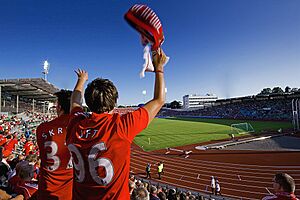
Oslo is home to the Holmenkollen National Arena. This is Norway's main venue for biathlon and Nordic skiing. It hosts annual world cup events. Oslo also hosted the 1952 Winter Olympics.
Oslo has several football clubs. Vålerenga, Lyn, and Skeid have won both the league and the cup. Ullevål Stadion is the home stadium for the Norway national team.
Skiing is a very popular activity in Oslo because of the cold climate and nearby forests. The Tryvann Ski Resort is the most used ski resort in Norway. Oslo is also home to successful ice hockey teams like Vålerenga Ishockey.
Bislett Stadium is the city's main venue for track and field. It hosts the annual Bislett Games.
Getting Around Oslo: Transport
Oslo has Norway's most extensive public transport system, managed by Ruter. This system includes:
- The five-line Oslo Metro, which runs underground through the city center.
- The six-line Oslo Tramway, which operates closer to the city center.
- The eight-line Oslo Commuter Rail.
- A bus network with 52 city lines and regional buses.
Oslo Central Station is the main train hub. It offers train services to most major cities in southern Norway, as well as to Stockholm and Gothenburg in Sweden. The Airport Express Train connects to the main airport. Ferries connect some city islands and nearby areas. Daily cruiseferry services go to cities like Copenhagen and Kiel.
Airports Serving Oslo
The main airport for Oslo is Gardermoen Airport. It is about 47 km (29 miles) from the city center. It is Norway's main international airport. Torp Airport is a secondary airport, about 110 km (68 miles) away. It serves some low-cost airlines.
Roads and Cars in Oslo
Many motorways in Oslo pass through tunnels. The roads are partly funded by a toll ring. The main motorways are European Route E6 and E18. Oslo has three ring roads.
Oslo has been working to reduce private car use and promote electric vehicles. In 2018, Oslo banned non-resident cars from its downtown areas. Oslo is known as the "electric vehicle capital of the world." This is because a large percentage of cars in the city are electric. Electric cars get benefits like cheaper tolls and free parking.
Oslo's Diverse Population
Oslo's population has been growing very quickly. In 2015, about 647,000 people lived in the Oslo municipality. The larger urban area had over 1 million people.
Oslo has the largest number of immigrants and children of immigrant parents in Norway. In 2015, about 30% of Oslo's population were immigrants or had immigrant parents. The areas with the highest numbers of people from immigrant backgrounds are Søndre Nordstrand, Stovner, and Alna.
The largest immigrant groups are from Pakistan, Somalia, and Poland. Other large groups come from Sweden, Iraq, and India. In 2013, 40% of primary school students in Oslo spoke a first language other than Norwegian or Sami.
Religion in Oslo
Oslo has many different religious communities. In 2019, about 48.7% of the population were members of the Church of Norway. Other Christian groups made up 8.4% of the population. About 9.5% of the population followed Islam, and 0.6% followed Buddhism. Many people in Oslo are not connected to any religion.
Famous People from Oslo
Many well-known people have lived in Oslo.
- Fridtjof Nansen (1861–1930) was a polar explorer and scientist. He won the Nobel Peace Prize.
- Trygve Lie (1896–1968) was a politician and the first Secretary-General of the United Nations.
- Gro Harlem Brundtland (born 1939) was a former Prime Minister of Norway.
- Jens Stoltenberg (born 1959) was also a former Prime Minister of Norway and is now the Secretary General of NATO.
- Henrik Ibsen (1828–1906) was a famous playwright.
- Edvard Munch (1863–1944) was a famous painter.
- Morten Harket (born 1959) is the lead singer of the band A-ha.
- Jo Nesbø (born 1960) is a popular writer and musician.
- Sonja Henie (1912–1969) was a three-time Olympic champion in figure skating.
- Grete Waitz (1953–2011) was a famous marathon runner.
- Kjetil André Aamodt (born 1971) is an alpine skier with many Olympic medals.
- Mats Zuccarello (born 1987) is a professional ice hockey player.
- Casper Ruud (born 1998) is a professional tennis player.
Oslo's Global Connections
Oslo works with other cities around the world. It is part of the Council of Europe and the European Commission's Intercultural cities program.
International Partnerships
Oslo has cooperation agreements with several cities, including:
 Gothenburg, Sweden
Gothenburg, Sweden Shanghai, China
Shanghai, China Vilnius, Lithuania
Vilnius, Lithuania Warsaw, Poland
Warsaw, Poland
Christmas Tree Gifts
Oslo has a special tradition of sending a Christmas tree every year to cities like Washington, D.C., New York City, London, and Reykjavík. Since 1947, Oslo has sent a large spruce tree to Britain. This is a way to thank Britain for its support during World War II.
See also
 In Spanish: Oslo para niños
In Spanish: Oslo para niños











